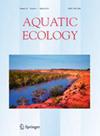Distribution and population structure of introduced rainbow trout Oncorhynchus mykiss in Cyprus
Abstract
Although rainbow trout Oncorhynchus mykiss has been widely introduced throughout Europe, self-sustaining populations are rare and unevenly distributed. In Cyprus, this invasive salmonid was introduced for recreational fishing at the end of the nineteenth century. To test whether rainbow trout have established in some water catchments of the island, between September 2020 and September 2022 we assessed the species’ distribution and analysed the age structure (by Bhattacharya’s method) and weight-length relationship of its major populations. The rainbow trout was recorded in 17 out of 86 sampling sites (19.7%), belonging to nine rivers and five catchments. Well-structured populations (N of cohorts ≥ 4) occurred in the River Kryos, where water temperatures were suitable for reproduction. Only a few individuals older than 4 years were sampled. Overall, both environmental conditions and population parameters suggest that the rainbow trout may self-sustain at least in the central, mountainous part of the island (rivers Kryos and Limnatis), where it occasionally coexists only with other introduced species. Nonetheless, its impact on native freshwater communities needs to be carefully assessed.

 求助内容:
求助内容: 应助结果提醒方式:
应助结果提醒方式:


